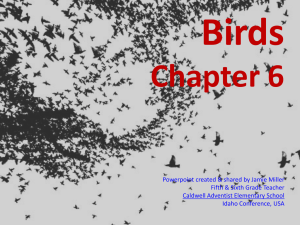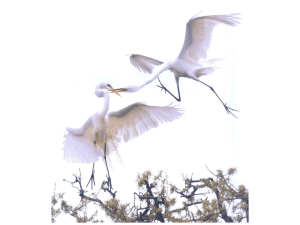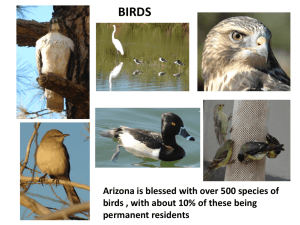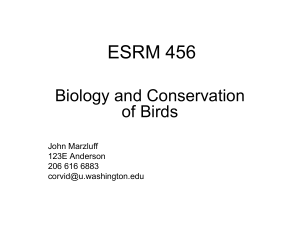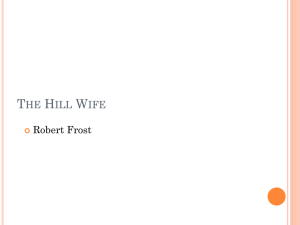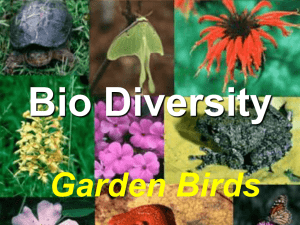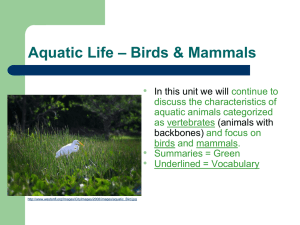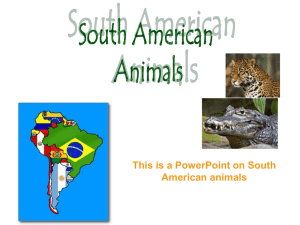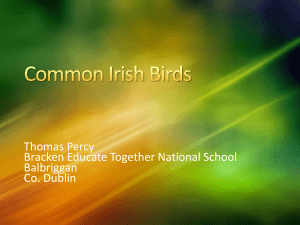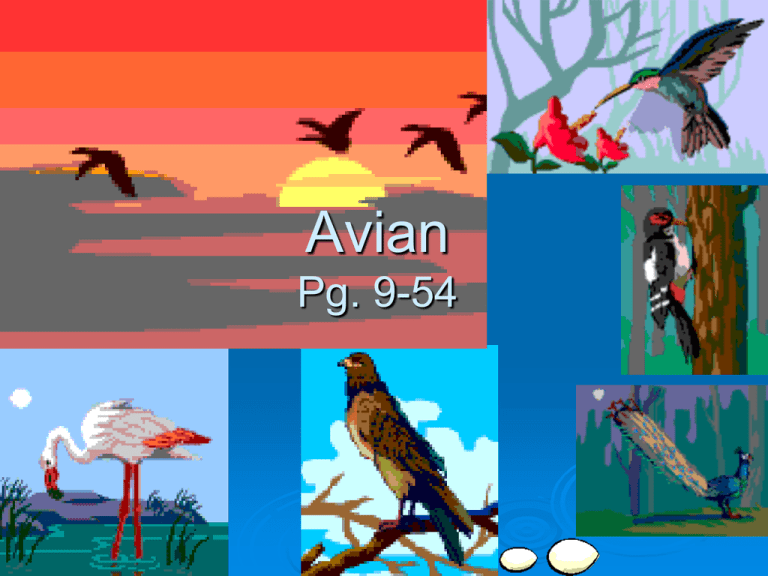
Avian
Pg. 9-54
Avian Anatomy
Avian anatomy, or the physiological structure of
bird’s bodies, shows many unique adaptations,
mostly aiding flight.
Avian have evolved a light skeletal system and
light but powerful musculature which, along with
circulatory and respiratory systems capable of
very high metabolic rates and oxygen supply,
permit the bird to fly.
The development of a beak has led to evolution
of a specially adapted digestive system. These
anatomical specializations have earned birds
their own class in the vertebrate phylum.
Topography
(External Anatomy)
Topography
(External Anatomy)
Integument
A bird’s body is covered by skin and its
derivates: the beak, claws, and feathers. These
structures cover and protect the internal organs
and block the entrance of disease-causing
organisms.
The skin of the birds consist of two layers; an
outer layer the epidermis and the inner layer
called dermis
The epidermis is relatively thin and consists of
flattened epithelial cells that produce keratin
The dermis is thicker and consists of a fibrous
connective tissue. Smooth muscles in the dermis
innervate feather follicles to help in the
regulation of heat
Integument
The
very thin skin is difficult to suture,
usually requiring 4-0 or 5-0 suture
The feet are an exception in that they
usually have tick, prominent scales in the
non-feather regions to protect them from
trauma
Birds bruise green because they lack
biliverdin reductase
Glands
Unlike mammals, birds don’t
posses sweat glands
The one major skin gland
that most birds posses is
called the uropygial gland
or preen gland located on the
dorsal surface at the upper
base of the tail
This gland secrets oily, fatty
substance and birds use
their beaks to spread around
their body
This gland is lacking in some
parrots (amazons), ostriches
and a few other species
Beaks
• Beak
One derivate of bird’s skin is
its beak or bill. It consists
of an upper and lower
mandible and is covered
with tough, horny keratin
layer that grows
continuously
Beaks vary in their hardness
and flexibility depending
on their function
Claws
Claws posses a horny
sheath derived from
specialized scales at the
end of each toe
Like beaks, they also
grow continuously
Species differ in the type
of claws they posses
based on heir perching
habits and methods of
procuring food
Talons
Feathers
Feathers are a unique feature of birds and they serve an
amazing variety of functions including:
Flight
Thermoregulation
Swimming
Protection
Hygiene
Water repellency
Tactile sensation
Support
Camouflage
Visual Communication
Birds have between 1000 and 25000
feathers
Feathers
Feathers are made of
keratin.
Keratin is produced in
the stratum corneum
and stratum
granulosum of the
epidermis.
Types of Feathers
Vaned or Contour
Feathers
Down
Semiplumes
Filoplumes
Bristles
Powder Down
Contour feather
Parts of a typical
contour or vaned
feather
remige = wing
retrix =tail
Semiplume feather
Semiplumes
are
intermediate
between contour
feathers and
down.
Their primary
function is
insulation.
Down feathers
Down feathers make
up the underplumage
of a bird. They are
usually concealed
beneath the contour
feathers, and their
main function appears
to be insulation against
the cold weather
Filoplumes
Filoplumes are
always situated
beside other
feathers. They are
simple, hairlike
structures that grow
in circles around the
base of contour or
down feathers. They
usually stand up like
hairs
Bristles
Not all species of birds
have bristle feathers.
Bristles are
specialized feathers
that are believed to
perform a tactile
function. They have a
stiff, tapered rachis
and few, if any barbs
that appear only at the
base of the feather
Molt
Molting is the replacement of feathers and it
occurs once several times a year depending of
the species
• New feathers pushed out from below by
replacement feathers produced in the feather
follicle
• Primary function is to replace worn feathers
• Augmentation of breeding plumage is secondary
• Molt imposes high energy demands
• Song birds 2000-4000 feathers
• Tundra Swan 25,000 feathers
Molt patterns reflect many selective
pressures
.Climate
• Migration
• Social system
• Food supplies
• Predators
• Competitors
Molt is an on-going, gradual
process
Skeleton
Modified for flight
Supports flight muscles (pectoral girdle,
keel/sternum)
Withstands stress of flight
Wings – fewer, fused digits
Reduced mass
Pneumatic bones- major bones hollow with struts,
air spaces connected to respiratory system
Fused bones- adds rigidity
Lack teeth- lightweight beak
Skeletal System
The bird skeleton is
highly adapted for flight. It
is extremely lightweight
but strong enough to
withstand the stresses of
taking off, flying, and
landing.
Birds also have more
cervical (neck) vertebrae
than many other animals;
most have a highly
flexible neck consisting of
8-25 vertebrae
One key adaptation is the
fusing of bones into
single ossifications
Pneumatic Bone
Not
completely hollow, has struts
Connected to respiratory system (air sacs
and lungs)
Major bones of body pneumatic (femur,
humerus and some vertebrae)
The number of hollow bones varies among
species, though large gliding and soaring
birds tend to have the most
http://nm.audubon.org/education/EE%20Chapter1/Chapter1.htm
Skeletal composition
A bird's head (skull) is dominated
by the large eye sockets
(orbits) which take up so much
space that the braincase
(cranium) is pushed to the
back
The skull consists of five major
bones: the frontal (top of
head), parietal (back of head),
premaxillary and nasal (top
beak), and the mandible
(bottom beak). The skull of a
normal bird usually weighs
about 1% of the birds total
bodyweight.
The chest consists of
the furcula (wishbone)
and coracoid (collar
bone), which two
bones, together with
the scapula form the
pectoral girdle. The
side of the chest is
formed by the ribs,
which meet at the
sternum (mid-line of the
chest).
The shoulder consists of the
scapula (shoulder blade),
coracoid (see The Chest),
and humerus (upper arm).
The humerus joins the
radius and ulna (forearm) to
form the elbow. The bones
in the wing are extremely
light so that the bird can fly
more easily.
The hips consist of the
pelvis which includes three
major bones: Illium (top of
the hip), Ischium (sides of
hip), and Pubis (front of the
hip). These are fused into
one (the innominate bone)..
Main Flight Muscles
Most birds have 175 different muscle, mainly controlling the
wings, skin and legs.
The largest muscle in the bird are the pectorals or the breast
muscles which control the wings and make up about 1525% of a flighted bird’s body weight.
The supracuracoideus and the pectoral together make up
about 25-35% of the bird’s full body weight.
Avian Digestive Tract
• Beak
– Excellent example of adaptation
to diet
– Highly specialized beaks such
as hummingbirds, crossbills,
and snail kite
– Prepare food for swallowing
– Remove poorly digested
portions (e.g. seed, snail
shells, bones)
Avian Digestive Tract
• Tongue – Has 3 primary roles
– Collecting food – sticky tongue of woodpeckers, long thin tongue
hummingbirds
– Manipulating food in mouth
• Muscular tongue of finches and parrots for handling seeds
• Fish eating birds have stiff papilla
• Filter feeding birds have bristles that mesh with lamellae on bill to form sieve
– Swallowing – may have papilla to direct food items toward the back of the
mouth
Avian Saliva
• Gray jays use saliva to
make balls of food to
store in trees
• Sticky tongue of
woodpeckers
• Swallow and swift
nests
• Bird-nest soup
Avian Digestive Tract
Digestive System
The crop functions to both
soften food and regulate its
flow through the system by
storing it temporarily. Members
of the order Columbiformes,
such as doves, produce a
nutritious crop milk which is
fed to their young by
regurgitation
Esophagus
Thin walled, highly
folded tube, larger
than in mammals
• Stomach – 2 parts
• Thin walled sacks in
carnivores
• Proventriculus
– Glandular, produces
acids and enzymes
• Ventriculus
– Muscular part of
stomach (Gizzard)
– Grinds food into
small particles (teeth)
– Large in herbivores
• Small Intestine –
Primary site digestion
and absorption
• Pancreatic secretions
– Bicarbonate for buffering
– Proteases
– Amylase
– Lipase
• Liver secretions
– Bile salts
• Ceca – blind pouches
at junction of small
and large intestine
• Contain microbes
– Fermentation
– Vitamins
– Nitrogen metabolism
– Water and electrolytes
• Large intestine
– Absorbs water and
stores feces
• Cloaca
cloaca is the
posterior opening that
serves as the only
such opening for the
intestinal, urinary, and
(usually) genital tracts
of certain animal
species
Cloacal Structure
Oviduct
Female Reproductive Tract
Ovary Most female
birds have one
functionally ovary (on
the left)
Infundibulum - site of
fertilization
Magnum - albumin
addition
Isthmus - membranes
Uterus - shell gland
Vagina - transport to
exterior
Sperm storage occurs
at various sites in tract
in some species
Reproductive cont..
Males have two testis and a
rudimentary fold of tissue
called a phallus instead of a
penis
Most bird species rub their
cloacal areas together to
transfer the male's sperm but
ostriches, rheas, strokes,
flamingos, ducks and a few
other families actually have
an erectile grooved penis on
the back wall of the cloaca to
transfer sperm.
Reproductive activity
The small species, such as
cockatiels, can be reproductively
active as early as 6 months of age
Larger species, such as macaws,
may not be reproductively active
until over 3 years of age
Cockatiels are prolific breeders,
and females can lay many eggs
even in the absence of a male bird
Commonly, egg-laying female
cockatiels on a seed diet become
egg bound, requiring ER medical
assistance
Incubation
Typically, an egg is formed in the uterus over 24 hours
The incubation period (from laying to hatching) for
budgie and cockatiel eggs is 18 to 21 days, respectively,
whereas for the African grey parrots, Amazon parrots,
and macaws it is app. 26 days
Some aviculturists allow the parent birds to incubate the
eggs and then remove the neonates from the nest at 10
days of age to be hand-fed, as is commonly practiced w/
parrots
Others will remove the eggs immediately after being laid
and place them in an incubator, then a hatcher, and then
hand-feed the neonates
Respiratory System
They lack a diaphragm,
have nonexpandable lungs
and a system of air sacs
which extend into many of
their bones.
Vocalization is by means of
a syrinx, not a larynx as in
mammals
Unidirectional air flow
System of air sacs
Average of 9
Chickens 8
Serve variety of functions
The nostrils or nares are
usually located at the base of
the beak. In psittacines
(parrots) they are located
within the area of the cere
The nasal cavity is divided
into a right and left side by a
nasal septum. This septum is
composed of cartilage and
bone
A large sinus known as the
infraorbital sinus, surrounds
the eye and extends into the
upper and lower beak
The larynx is at the entrance
of the trachea. The opening
of the larynx is the glottis.
Birds differ from mammals in
that the larynx does not have
vocal chords and therefore is
not involved in voice
production.
The trachea is formed by a
series of ring-shaped
cartilages, which are
completely closed in birds*
The trachea bifurcates
(divides) after entering the
thoracic cavity. The syrinx or
voice box is located at this
bifurcation.
*easy to intubate
The nine air sacs also act
as a cooling system since
birds do not have sweat
glands.
Anatomically, their lungs
are connected to large
thin-walled air sacs,
which appear to function
sort of like bellows rather
than like lungs, such that
they have a minimal
blood supply and they
are not involved in gas
exchange.
Oxygen exchange in the
bird occurs on inspiration
and expiration
Renal System
Mammalian and reptilian type nephrons
are present, therefore birds produce liquid
urine and pasty white urates
Note that kidney in birds is not measured
by BUN and creatinine levels, but by levels
of uric acid
Cardiovascular System
Birds have very efficient cardiovascular systems that
permit them to meet the metabolic demands of flight
(and running, swimming, or diving).
The cardiovascular system not only delivers oxygen to
body cells (and removes metabolic wastes) but also
plays an important role in maintaining a bird's body
temperature.
The avian circulatory system consists of a heart plus
vessels that transport:
-nutrients
-oxygen and carbon dioxide
-waste products
-hormones
-heat
Birds, like mammals, have
a 4-chambered heart (2
atria & 2 ventricles), with
complete separation of
oxygenated and deoxygenated blood.
The right ventricle pumps
blood to the lungs, while the
left ventricle pumps blood to
the rest of the body.
Avian hearts also tend to pump more blood per unit time
than mammalian hearts. Cardiac output is influenced by
both heart rate (beats per minute) and stroke volume (blood
pumped with each beat). The renal-portal system (that
system in which blood from caudal half of body can go to
the kidney before going go the heart) exists in these
patients

